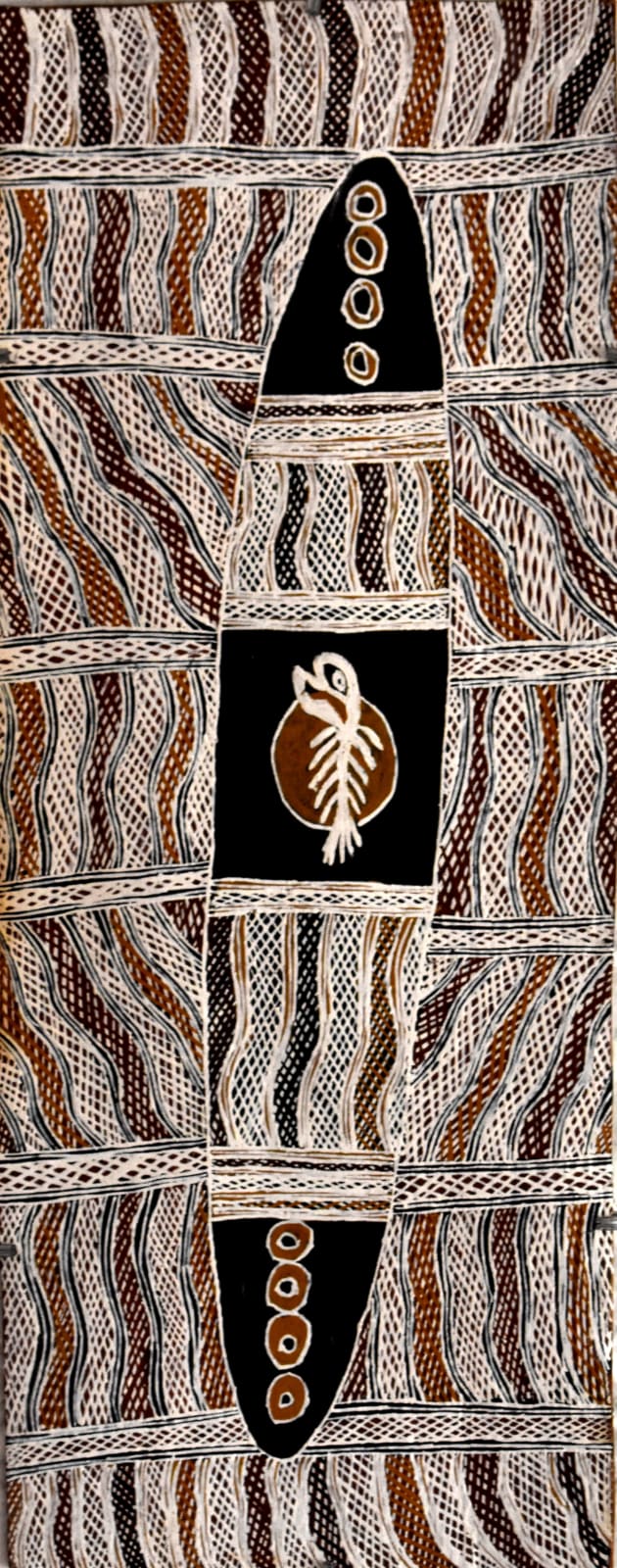SPOTLIGHT ON ARTWORK 1K AND UNDER: A LOOK AT BEAUTIFUL WORKS 1K & UNDER
Forthcoming viewing_room
Mena Munungurr Yanalka Australian, Yolngu, b. 1959
Yinapunapu, 2019
Earth pigment on stringybark
66 x 26 cm
841891
The miny’tji (sacred clan design) painted on this piece identifies the Dhalwaŋu saltwater estate of Garraparra on Blue Mud Bay. Here is the sacred site for the Dhalwaŋu Yiŋapuŋapu, a...
The miny’tji (sacred clan design) painted on this piece identifies the Dhalwaŋu saltwater estate of Garraparra on Blue Mud Bay. Here is the sacred site for the Dhalwaŋu Yiŋapuŋapu, a mortuary based sand sculpture used for the initial rites of the dead. The deceased placed within the Yiŋapuŋapu’s elliptical confines has its own contamination kept at bay.
The Yiŋapuŋapu is the low relief sand sculpture used traditionally to keep the contamination of initial mortuary at bay. It is used in ritual by the Maŋgalili, Maḏarrpa and the Dhalwaŋu clans. Detail in its construction identifies particular clan ownership thus tenure to its particular site, Dhalwaŋu saltwater country at Garraparra, a peninsula within Blue Mud Bay.
A giant tide (tsunami) that capsized the ancestral Turtle Hunters canoe called Yinikambu washed it back to shore from the waters there out deep, to cleanse the site of Yiŋapuŋapu, the waters then imbued with the deceased's Dhalwaŋu life force washes back out to the sanctified saltwater’s of Garraparra. Their paraphernalia still floats in these waters maintaining the link between these clans.
The hooked spears sit under the Madurai (Casuarina) trees at the place Bat’wuy and conjures the connections between the ancient mariners and the law of mortuary for Dhalwangu. The ceremony is at its conclusion with Yambirrku (Parrot fish) within the ground. Gunyan the sand crab cleanse and renew. It is happening in the distant time before time and also in the present and the far future. The fish can also be a representation of the bones of the deceased.
The design also references Mamaparra also known as Nyapiliŋu the spirit woman and the islands Gunyuru and Gamarraliŋa. Sometimes referenced is the maternal Thunderhead cloud Waŋupini. This is shown in its feminine shape as the anvil shaped Wet Season cumulo-nimbus. There is a metaphor for the soul’s journey from life to death to rest to rebirth. The saltwater flows to the horizon where it is taken up as water vapour by the feminine thunderhead cloud which carries it as the pregnant maternal shape to the escarpment where it gives birth through rain.
The Yiŋapuŋapu is the low relief sand sculpture used traditionally to keep the contamination of initial mortuary at bay. It is used in ritual by the Maŋgalili, Maḏarrpa and the Dhalwaŋu clans. Detail in its construction identifies particular clan ownership thus tenure to its particular site, Dhalwaŋu saltwater country at Garraparra, a peninsula within Blue Mud Bay.
A giant tide (tsunami) that capsized the ancestral Turtle Hunters canoe called Yinikambu washed it back to shore from the waters there out deep, to cleanse the site of Yiŋapuŋapu, the waters then imbued with the deceased's Dhalwaŋu life force washes back out to the sanctified saltwater’s of Garraparra. Their paraphernalia still floats in these waters maintaining the link between these clans.
The hooked spears sit under the Madurai (Casuarina) trees at the place Bat’wuy and conjures the connections between the ancient mariners and the law of mortuary for Dhalwangu. The ceremony is at its conclusion with Yambirrku (Parrot fish) within the ground. Gunyan the sand crab cleanse and renew. It is happening in the distant time before time and also in the present and the far future. The fish can also be a representation of the bones of the deceased.
The design also references Mamaparra also known as Nyapiliŋu the spirit woman and the islands Gunyuru and Gamarraliŋa. Sometimes referenced is the maternal Thunderhead cloud Waŋupini. This is shown in its feminine shape as the anvil shaped Wet Season cumulo-nimbus. There is a metaphor for the soul’s journey from life to death to rest to rebirth. The saltwater flows to the horizon where it is taken up as water vapour by the feminine thunderhead cloud which carries it as the pregnant maternal shape to the escarpment where it gives birth through rain.
